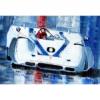
R.A.F roundels on Belgian C-type
#1

Posted 04 March 2003 - 23:17
Advertisement
#2

Posted 05 March 2003 - 13:17
I've heard of them but never understoon how the rules worked.
#3

Posted 05 March 2003 - 14:34
Originally posted by D-Type
Could they be for the Coupe Biennial or Coupe Trienniel?
I've heard of them but never understoon how the rules worked.
Amazing what's been discussed in TNF .....
http://www.atlasf1.c...&threadid=47675
Mind you, I'm not sure you'll be any clearer after reading it!
#4

Posted 05 March 2003 - 15:07
#5

Posted 05 March 2003 - 16:25
Also, during the sixties, Le Mans entries often had yellow or red color spots. Look at the '67 Gurney-Foyt Mark IV winner, there are yellow spots on the roof near the front window pillars.
I think it's some code from the Le Mans organizer but I have never known the meaning.
#6

Posted 05 March 2003 - 16:29
#7

Posted 05 March 2003 - 17:38
#8

Posted 05 March 2003 - 20:06
Originally posted by David T.
May be the single colours of the roundels referred to the bodywork different materials just in order to let firemen immediatley know if a car was going to catch easily fire or not?
Difficult to imagine they would have thought of this before 1955...
#9

Posted 05 March 2003 - 23:02
There were fairly complicated criteria laid down to ensure that cars were not holding speeds down in the early stages, with 6-hourly checks being made to ensure that minimum distances were being covered. Failure to maintain these averages resulted in disqualification from the Cup.
Teams that met the minimum set averages would qualify for the Triennial (later Biennial) Cup, and would have to perform likewise the following year, and those cars wearing the roundels showed that they had qualified from the previous year's event.
#10

Posted 06 March 2003 - 02:45
This is what is what I thought these meant but I have no basis what-so-ever for thinking this. (If this is true, was it a reaction to the magnesium Honda burning-up, on French soil IIRC?)Originally posted by David T.
May be the single colours of the roundels referred to the bodywork different materials just in order to let firemen immediatley know if a car was going to catch easily fire or not?
Ray - I do not see the single colored spots on cars run there in the fifties.
#11

Posted 06 March 2003 - 07:32
However, I would think that it would more likely be related to the 1955 crash and the problem there with burning elekron, at least as much as it might have been to do with Schlesser's fire.
#12

Posted 06 March 2003 - 08:59
Originally posted by ensign14
British car so British roundels? They later added a green stripe to the Belgian yellow so they were keen to reflect the original nationality of the car. (Think it was Francorchamps who did this.) Did anyone else have aircraft roundels on their car of any sort? Did any of the French cars have the French roundel - for some reason that rings a bell?
Hi ensign14
A Renault 4CV had the french roundel but i think it was more a patriotic thing
but I don't know if it's was for Le Mans or some Rallies:

Sorry if a thread has already mentioned the 4CV.
Toine
#13

Posted 06 March 2003 - 12:47
#14

Posted 06 March 2003 - 18:37
Barry, are you assembling a model of this Jaguar?
No, but I purchased a 1/43rd scale model of the car on Tuesday. It is a 'Top Model' model, and the display box has a GREEN outer cover. This is new to me; all my other Top Model boxes are red or yellow.
I don't know if this makes this model particularly old or rare....
Anyway, here it is:
Incidentally, on reflection, I suppose those roundels could be French; they are the right colours. I am not an aviation expert!
#15

Posted 06 March 2003 - 19:27
#16

Posted 06 March 2003 - 19:31
What a strange choice......
#17

Posted 06 March 2003 - 20:49
I wonder if the yellow Jaguar wore the RAF roudels or rather the belgian roundels?
Not only the small Renault wore the french roundels but also the Talbot but not Gordini.
#18

Posted 06 March 2003 - 21:15
Do you know how qualifying for the Bienniel Cup worked?
David Hodges History of Le mans P 57 shows the Cunningham/Huntoon C2R with a roundel and the Rand/Wacker car without one in the 1951 race and on other pages some of the cars have roundels and some not.
Those with roundels appear to have a driver who had finished the year before so I would guess the qualifying criterion was one of the drivers had to have finished the year before.
Does anybody know for sure?
#19

Posted 07 March 2003 - 00:20
By the way, the BRM logo is actually an RAF roundel with a motif superimposed.
Advertisement
#20

Posted 07 March 2003 - 17:57
As mentioned previously, cars were eliminated from the competition by failing to meet the set distances during a six-hour session - i.e. Any car 20% below the set target during the first six hours was excluded, 15% below at twelve hours and 10% below at 18 hours were all disqualified. All cars which succeeded in meeting or exceeding their handicap targets, and managed to finish the race, would then qualify for the competition the following year. The result was determined by the marque showing the greatest proportionate distance above their target over the two successive years.
The contest was formulated from the outset of the Grand Prix d'Endurance in 1923 when Charles Faroux conceived the idea of a 24-hour race which would test the efficiency of electrical equipment and lighting and lead to improvements which could be passed on to the car-buying public. He obtained support from Georges Durand, secretary general of the AC de l'ouest, and Emile Coquille, who was MD of the French arm of the Rudge-Whitworth Wheel Company, and hence their support for this interesting subsidiary contest - although when the first event was run, it was seen merely as the first round of this Triennial Cup competition. It lasted, I think, until the late fifties/early sixties.
Can anyone add anything else to this somewhat sketchy assessment?
#21

Posted 24 March 2003 - 13:16
















